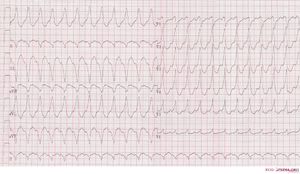Ventricular Tachycardia: Difference between revisions
m (New page: {{Chapter|Ventricular Arrhythmias}} {{Arrhythmias| | name = Ventricular Tachycardia (VT or V-tach) | locatieImage = | atrial_frequency = 60-100 bpm | ventricular_frequency = 110-250 bpm |...) |
(No difference)
|
Revision as of 19:48, 22 July 2007
| This is part of: Ventricular Arrhythmias |
Ventricular tachycardia is defined as a sequence of three or more ventricular beats. The frequency must by higher than 100 bpm, mostly it is 110-250 bpm.
Ventricular tachycardias often origin around old scar tissue in the heart, e.g. after myocardial infarction. Also electrolyte disturbances and ischemia can cause ventricular tachycardias. The cardiac output is often strongly reduced during VT resulting in hypotension and loss of conciousness. VT is a medical emergency as it can deteriorate into Ventricular fibrillation and thus mechanical cardiac arrest.
Ventricular tachycardia can be catechorized as follows:
Non-sustained VT
Non-sustained VT is defined three or more ventricular beats with a maximal duration of 30 seconds.
Sustained VT
Sustained VT is defined as a VT of more than 30 seconds duration (or less if treated by electrocardioversion within 30 seconds).
Monomorphic VT
All ventricular beats have the same configuration.
Polymorphic VT
The ventricular beats have a changing configuration. The RR interval is 180-600 ms (comparable to a heart rate of 100-333 bpm).

